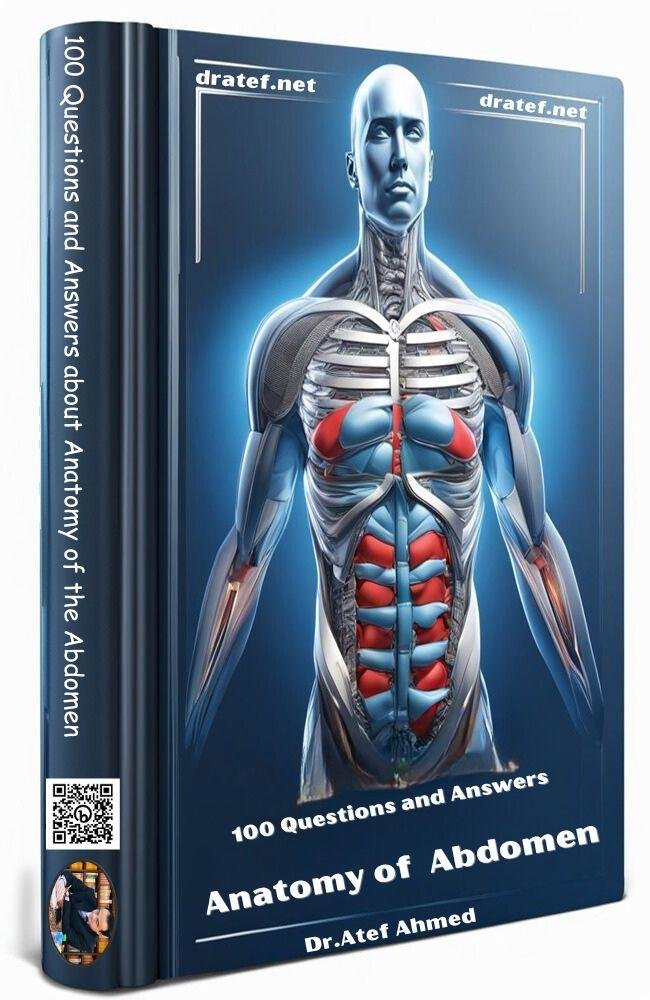100 Questions and Answers about Anatomy of the Abdomen by Dr. Atef Ahmed
Get Free Copy Now and share links
https://www.amazon.com/dp/B0CW1BLTHJ
100 Questions and Answers For Medical Students and Doctors (32 books)
https://www.amazon.com/dp/B0CTS66BYM
Other books
https://amazon.com/author/dratef https://x.com/DrATEFAHMED/status/1767665824150454758?s=20 https://www.instagram.com/reel/C4bfbs-tspC/?utm_source=ig_web_copy_link&igsh=MzRlODBiNWFlZA== https://www.threads.net/@dr.atefahmed/post/C4bfp7vt7G7
Perfect your understanding of abdominal anatomy with this essential question and answer guide!
The complex organs contained within the abdomen play integral roles in digestion, metabolism, fluid balance, and immunity. Mastery of abdominal anatomy is crucial for medical students and clinicians specializing in this complex bodily region.
In this book, Dr. Atef Ahmed draws on his extensive teaching experience to deliver 100 expertly crafted questions and answers covering all essential topics in abdominal anatomy. The high-yield Questions and Answers format facilitates retention and self-testing on core concepts like:
The anatomical divisions and functions of the peritoneum.
The major gastrointestinal organs and their vasculature.
The liver and biliary system.
The pancreatic ductal anatomy and arterial supply.
The kidneys, adrenal glands, and ureters.
Abdominal vasculature including the portal venous system.
Lymphatic drainage pathways and lymph nodes.
Concise yet comprehensive explanations clarify challenging topics and provide clinical insights.
Whether you are currently enrolled in an anatomy course or desire a refresher guide on abdominal anatomy, this book provides the essential knowledge and practice you need to master this vital bodily region. The Questions and Answers format also makes it easy to quickly look up topics during clinical rounds. A must-have resource for all medical students, general surgery residents, radiologists, gastroenterologists, and other specialists who require expert anatomical knowledge of the abdomen.
Get Your Copy Now From Amazon At low Price.
1. abdominal anatomy question and answer book
2. abdominal anatomy study guide
3. abdominal anatomy quiz book
4. abdomen anatomy questions
5. abdominal anatomy review book
6. abdominal anatomy test prep
7. abdominal anatomy questions and answers book
abdominal anatomy, abdomen anatomy, abdominal dissection, abdominal organs, gastrointestinal anatomy, digestive anatomy, abdominal vasculature, peritoneal anatomy, abdominal lymphatics, abdominal muscles, abdominal wall, abdominal quadrants, gastrointestinal tract, digestive system, abdominal viscera, abdomen anatomy book, abdomen quiz book, abdominal review book, abdominal exam prep, abdominal anatomy study guide, abdomen study cards, abdomen flashcards, abdominal anatomy questions, abdomen question bank, abdominal anatomy mcqs, abdomen anatomy mock test, abdomen anatomy practice test, abdomen anatomy workbook, abdomen anatomy curriculum, medical abdomen anatomy, nursing abdomen anatomy, vet abdomen anatomy, radiology abdomen anatomy, abdomen mri anatomy, abdomen ct anatomy, abdomen dissection guide, clinical abdomen anatomy, applied abdomen anatomy, surgical abdomen anatomy, abdomen anatomy for surgeons, abdomen anatomy for physicians, abdomen anatomy for students, abdomen anatomy for dummies, vet student abdomen anatomy, nursing student abdomen anatomy, medical student abdomen anatomy, physio abdomen anatomy, radiographer abdomen anatomy, radiologist abdomen anatomy, cardiologist abdomen anatomy,
#abdominalanatomy,
#abdomenanatomy,
#anatomy,
#abdomendissection,
#abdominalorgans,
#gastrointestinalanatomy,
#digestiveanatomy,
#abdominalvasculature,
#peritonealanatomy,
#abdominallymphatics,
#abdominalmuscles,
#abdominalwall,
#abdominalquadrants,
#gastrointestinaltract,
#digestivesystem,
#abdominalviscera,
#anatomybook,
#anatomyquiz,
#anatomyreview,
#anatomyexam,
#anatomystudyguide,
#anatomystudycards,
#anatomyflashcards,
#anatomymcqs,
#anatomymocktest,
#anatomypracticetest,
#anatomyworkbook,
#anatomycurriculum,
#medstudentanatomy,
#nursingstudentanatomy,
#vetstudentanatomy,
#radiologyanatomy,
#mrianatomy,
#ctanatomy,
#dissectionguide,
#clinicalanatomy,
#appliedanatomy,
#surgicalanatomy,
#surgeonanatomy,
#physiciananatomy,
#studentanatomy,
#anatomyfordummies,
#anatomy101,
#physioanatomy,
#radiographeranatomy,
#radiologistanatomy,
#cardiologistanatomy,
#anatomyrocks,
#lovetolearnanatomy,
#anatomyessentials
Here are some professional prompts to generate AI photos for the book cover and banner for "100 Questions and Answers about Anatomy of the Abdomen" by Dr. Atef Ahmed:
Book Cover Prompts:
- Anatomy textbook cover titled "100 Questions & Answers About Anatomy of the Abdomen" by Dr. Atef Ahmed, close up view of a gray's anatomy style abdominal muscular figure with internal organs exposed including esophagus, stomach, liver, intestines, kidneys. Text is white, modern, and scientific.
- Close up view of a human male abdomen anatomy model, shows detailed muscles, blood vessels, and internal organs. Orange and blue color scheme. Title text "100 Questions & Answers About Anatomy of the Abdomen". Author name "Dr. Atef Ahmed" in bold white letters at the bottom.
- Illustration of the anterior view of male human abdominal anatomy, detailed internal organs visible including stomach, liver, intestines, kidneys, blood vessels. Bright lighting with shadows. Title "100 Questions & Answers About Anatomy of the Abdomen" in large white letters vertically covering abdomen. Author name small at bottom.
Banner Prompts:
- Wide banner with flat lay of an open abdomen anatomy book, notebook, pencil, muscles and organs model. Title text "100 Questions & Answers About Anatomy of the Abdomen" in bold white letters prominently displayed. Author name "Dr. Atef Ahmed" below in smaller font.
- Facebook banner for new anatomy book release "100 Questions & Answers About Anatomy of the Abdomen" by Dr. Atef Ahmed. Flat lay of book with abdomen anatomy model, stethoscope, lab coat. Blue and white color scheme, modern, scientific aesthetic.
- Wide illustrated banner with muscles and internal organs of abdomen anatomy. Bright lighting and colors. Title "100 Questions & Answers About Anatomy of the Abdomen" taking up most of banner space, by Dr. Atef Ahmed in small print near bottom. Clean, minimalist, modern design.
100 Questions and Answers about Anatomy of the Abdomen by Dr. Atef Ahmed
Get Free Copy Now and share links
https://www.amazon.com/dp/B0CW1BLTHJ
100 Questions and Answers For Medical Students and Doctors (32 books)
https://www.amazon.com/dp/B0CTS66BYM
Other books
https://amazon.com/author/dratef
https://x.com/DrATEFAHMED/status/1767665824150454758?s=20
https://www.instagram.com/reel/C4bfbs-tspC/?utm_source=ig_web_copy_link&igsh=MzRlODBiNWFlZA==
https://www.threads.net/@dr.atefahmed/post/C4bfp7vt7G7
Perfect your understanding of abdominal anatomy with this essential question and answer guide!
The complex organs contained within the abdomen play integral roles in digestion, metabolism, fluid balance, and immunity. Mastery of abdominal anatomy is crucial for medical students and clinicians specializing in this complex bodily region.
In this book, Dr. Atef Ahmed draws on his extensive teaching experience to deliver 100 expertly crafted questions and answers covering all essential topics in abdominal anatomy. The high-yield Questions and Answers format facilitates retention and self-testing on core concepts like:
The anatomical divisions and functions of the peritoneum.
The major gastrointestinal organs and their vasculature.
The liver and biliary system.
The pancreatic ductal anatomy and arterial supply.
The kidneys, adrenal glands, and ureters.
Abdominal vasculature including the portal venous system.
Lymphatic drainage pathways and lymph nodes.
Concise yet comprehensive explanations clarify challenging topics and provide clinical insights.
Whether you are currently enrolled in an anatomy course or desire a refresher guide on abdominal anatomy, this book provides the essential knowledge and practice you need to master this vital bodily region. The Questions and Answers format also makes it easy to quickly look up topics during clinical rounds. A must-have resource for all medical students, general surgery residents, radiologists, gastroenterologists, and other specialists who require expert anatomical knowledge of the abdomen.
Get Your Copy Now From Amazon At low Price.
1. abdominal anatomy question and answer book
2. abdominal anatomy study guide
3. abdominal anatomy quiz book
4. abdomen anatomy questions
5. abdominal anatomy review book
6. abdominal anatomy test prep
7. abdominal anatomy questions and answers book
abdominal anatomy, abdomen anatomy, abdominal dissection, abdominal organs, gastrointestinal anatomy, digestive anatomy, abdominal vasculature, peritoneal anatomy, abdominal lymphatics, abdominal muscles, abdominal wall, abdominal quadrants, gastrointestinal tract, digestive system, abdominal viscera, abdomen anatomy book, abdomen quiz book, abdominal review book, abdominal exam prep, abdominal anatomy study guide, abdomen study cards, abdomen flashcards, abdominal anatomy questions, abdomen question bank, abdominal anatomy mcqs, abdomen anatomy mock test, abdomen anatomy practice test, abdomen anatomy workbook, abdomen anatomy curriculum, medical abdomen anatomy, nursing abdomen anatomy, vet abdomen anatomy, radiology abdomen anatomy, abdomen mri anatomy, abdomen ct anatomy, abdomen dissection guide, clinical abdomen anatomy, applied abdomen anatomy, surgical abdomen anatomy, abdomen anatomy for surgeons, abdomen anatomy for physicians, abdomen anatomy for students, abdomen anatomy for dummies, vet student abdomen anatomy, nursing student abdomen anatomy, medical student abdomen anatomy, physio abdomen anatomy, radiographer abdomen anatomy, radiologist abdomen anatomy, cardiologist abdomen anatomy,
#abdominalanatomy, #abdomenanatomy, #anatomy, #abdomendissection, #abdominalorgans, #gastrointestinalanatomy, #digestiveanatomy, #abdominalvasculature, #peritonealanatomy, #abdominallymphatics, #abdominalmuscles, #abdominalwall, #abdominalquadrants, #gastrointestinaltract, #digestivesystem, #abdominalviscera, #anatomybook, #anatomyquiz, #anatomyreview, #anatomyexam, #anatomystudyguide, #anatomystudycards, #anatomyflashcards, #anatomymcqs, #anatomymocktest, #anatomypracticetest, #anatomyworkbook, #anatomycurriculum, #medstudentanatomy, #nursingstudentanatomy, #vetstudentanatomy, #radiologyanatomy, #mrianatomy, #ctanatomy, #dissectionguide, #clinicalanatomy, #appliedanatomy, #surgicalanatomy, #surgeonanatomy, #physiciananatomy, #studentanatomy, #anatomyfordummies, #anatomy101, #physioanatomy, #radiographeranatomy, #radiologistanatomy, #cardiologistanatomy, #anatomyrocks, #lovetolearnanatomy, #anatomyessentials
Here are some professional prompts to generate AI photos for the book cover and banner for "100 Questions and Answers about Anatomy of the Abdomen" by Dr. Atef Ahmed:
Book Cover Prompts:
- Anatomy textbook cover titled "100 Questions & Answers About Anatomy of the Abdomen" by Dr. Atef Ahmed, close up view of a gray's anatomy style abdominal muscular figure with internal organs exposed including esophagus, stomach, liver, intestines, kidneys. Text is white, modern, and scientific.
- Close up view of a human male abdomen anatomy model, shows detailed muscles, blood vessels, and internal organs. Orange and blue color scheme. Title text "100 Questions & Answers About Anatomy of the Abdomen". Author name "Dr. Atef Ahmed" in bold white letters at the bottom.
- Illustration of the anterior view of male human abdominal anatomy, detailed internal organs visible including stomach, liver, intestines, kidneys, blood vessels. Bright lighting with shadows. Title "100 Questions & Answers About Anatomy of the Abdomen" in large white letters vertically covering abdomen. Author name small at bottom.
Banner Prompts:
- Wide banner with flat lay of an open abdomen anatomy book, notebook, pencil, muscles and organs model. Title text "100 Questions & Answers About Anatomy of the Abdomen" in bold white letters prominently displayed. Author name "Dr. Atef Ahmed" below in smaller font.
- Facebook banner for new anatomy book release "100 Questions & Answers About Anatomy of the Abdomen" by Dr. Atef Ahmed. Flat lay of book with abdomen anatomy model, stethoscope, lab coat. Blue and white color scheme, modern, scientific aesthetic.
- Wide illustrated banner with muscles and internal organs of abdomen anatomy. Bright lighting and colors. Title "100 Questions & Answers About Anatomy of the Abdomen" taking up most of banner space, by Dr. Atef Ahmed in small print near bottom. Clean, minimalist, modern design.






